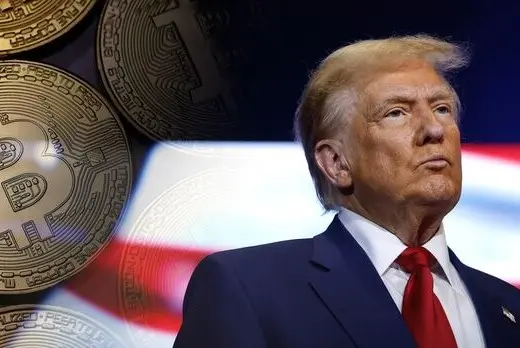Trump’s crypto agenda in 2025 could transform digital asset regulations and innovation.
Explore what the crypto industry expects from Trump’s crypto agenda in 2025 and their global implications for blockchain, DeFi, and the future of cryptocurrency markets.
Trump’s Historical Stance on Crypto
Donald Trump’s stance on cryptocurrencies has changed over time, from harsh criticism during his first presidency to a more crypto-friendly stance in his current political endeavors. Here’s a summary of his historical perspectives:
- Public Criticism During Presidency:
During his first presidency, Trump publicly criticized Bitcoin and other cryptocurrencies, labeling them “not money” and claiming their value was based on “thin air.”
He also raised concerns about crypto being used for illegal activities such as drug trafficking and fraud. Trump also emphasized the risk of unregulated digital assets eroding the US dollar’s dominance.
- Bitcoin as a “Threat to the Dollar”:
Trump criticized Bitcoin as a “threat to the dollar” in a 2021 interview, labeling it a “scam” and stating his support for the US dollar as the global currency standard.
He expressed doubts about cryptocurrency competing with fiat currencies.
- Impact of Trump-Era Policies:
Trump’s government established strict compliance with AML and KYC standards but did not directly adopt significant crypto regulations. Agencies like FinCEN and the SEC have strongly monitored crypto-related activities but do not have a comprehensive framework.
- Shift in Tone Post-Presidency:
Trump’s crypto stance has changed in recent years despite his initial skepticism. In late 2022, he launched a non-fungible token (NFT) collection, indicating a more pragmatic approach.
By 2023, reports revealed he had digital assets worth up to $500,000, indicating a likely pivot towards crypto engagement.
This historical context lays the foundation for understanding how Trump’s crypto agenda in 2025 and beyond might influence the sector.
The Crypto Landscape Under Biden
Overview of Crypto Regulations and Enforcement
The crypto sector has been subjected to greater regulatory scrutiny during the Biden administration, reflecting a focus on investor protection, financial stability, and the prevention of illegal activity. Key developments include:
Executive Order on Digital Assets: President Biden signed an executive order in March 2022 that aimed to establish a unified framework for digital asset management in the United States.
This directive encouraged federal agencies to collaborate on addressing risks like money laundering while fostering innovation in blockchain technologies.
Regulatory Clarity Issues: One major problem has been the question of whether cryptocurrencies should be classified as securities or commodities.
The Securities and Exchange Commission (SEC) has aggressively pursued enforcement actions against exchanges such as Coinbase and Binance for alleged unregistered securities trading.
Simultaneously, the Commodity Futures Trading Commission (CFTC) has sought wider jurisdiction over crypto commodities.
Focus on Stablecoins and DeFi: Regulatory bodies have also focused on stablecoins and decentralized finance (DeFi).
The fall of TerraUSD raised concerns, prompting new stablecoin issuance guidelines. Additionally, the Treasury’s push to regulate anonymous wallets demonstrates a commitment to fighting fraud.
Industry Challenges:
- Lack of clear guidelines: In the absence of a clear regulatory framework, crypto firms are left in regulatory limbo, fearing lawsuits and large fines while attempting to innovate within uncertain boundaries.
- Market Volatility and Risk: The ongoing market instability, exacerbated by enforcement actions and scandals (e.g., FTX collapse), has challenged investor trust and disrupted the industry.
Comparing Biden and Trump’s Crypto Agenda
While Biden’s approach has prioritized enforcement and risk reduction, Trump’s crypto agenda may differ.
Trump has been skeptical of Bitcoin and cryptocurrencies in the past, and his future stance could lean toward tightening regulations to protect the US dollar’s dominance while balancing economic growth.
This juxtaposition highlights the evolving nature of US crypto policy depending on the administration in power.
The current regulatory environment under Biden indicates a conservative approach to crypto, focusing on risk management rather than quick innovation. Understanding this context is critical for assessing the potential shifts in Trump’s crypto agenda in 2025 and beyond.
Key Themes in Trump’s Potential Crypto Agenda
Donald Trump’s crypto agenda in 2025 and beyond includes significant changes to US crypto regulations, strategic economic initiatives, and efforts to transform the global crypto landscape. Here are the primary areas of focus:
Pro-Crypto Regulation: Trump has pledged to create a more crypto-friendly regulatory environment, including replacing SEC leadership with pro-crypto officials.
This change aims to promote the United States as the worldwide hub for decentralized finance, moving away from the SEC’s enforcement-heavy policies.
Opposition to CBDCs: Trump has taken a strong stance against central bank digital currencies (CBDCs), seeing them as threats to financial privacy and competition. He has promised to keep decentralized cryptos like Bitcoin from being overtaken by government-issued digital currencies.
Strategic Bitcoin Reserve: A key proposal involves establishing a national Bitcoin reserve to boost the United States’ economic position and dominance in the global crypto market. This step aligns with his bigger vision of integrating crypto into national fiscal strategy.
Crypto Mining Advocacy: Trump supports increasing domestic Bitcoin mining by lowering regulatory barriers and positioning the United States as a leader in this field.
This highlights his alignment with pro-crypto policymakers who regard Bitcoin mining as a key economic opportunity.
Crypto Self-Custody Rights: Emphasizing financial autonomy, Trump has proposed enshrining the right to self-custody of crypto assets, supporting notions like “not your keys, not your coins” to safeguard investors from restrictive regulations.
Establishing a Crypto Advisory Council: During his first 100 days in office, Trump intends to form a presidential crypto advisory council to provide clearer regulations. The council would aim to resolve issues regarding regulatory ambiguity in the cryptocurrency industry.
While these initiatives present opportunities for crypto adoption, they face political and implementation challenges. These efforts could redefine the United States’ approach to cryptos, potentially promoting innovation and strengthening its global leadership in the sector.
Challenges of Implementing Trump’s Crypto Agenda
Implementing Trump’s crypto agenda would encounter a number of challenges due to regulatory dynamics, congressional resistance, and global trends. Here’s a breakdown of the possible challenges:
- Resistance from Congress and Regulatory Bodies
- Congressional Divide: Although Trump’s crypto agenda might align with the Republican-controlled Congress, bipartisan disagreements over the scope of crypto regulation could slow progress.
Some legislators prioritize supporting innovation, while others advocate for more intense investor protections.
- Regulatory Power Struggles: Trump’s plan to broaden the Commodity Futures Trading Commission’s (CFTC) jurisdiction over crypto could face opposition from the SEC.
The SEC has previously classified many crypto assets as securities, resulting in turf battles between these agencies. To resolve this disagreement will require strong legislative backing to redefine jurisdictional boundaries.
- Balancing Innovation and Regulation
Overly lenient regulations might expose the market to risks such as fraud and money laundering, whereas excessive control may impede blockchain innovation and discourage crypto businesses from operating in the United States.
Striking this balance will be essential for establishing policies that safeguard investors but not alienating startups or global companies seeking regulatory clarity.
- Global Regulatory Pressure
As the global crypto market becomes more interconnected, the United States should consider aligning its policies with international standards. Organizations such as the Financial Action Task Force (FATF) and the European Union are advancing crypto regulations.
If the US lags behind or implements policies that contradict these efforts, it risks losing its leadership in the sector.
Countries like China and the EU are developing clear regulations and setting standards that U.S. authorities may feel pushed to match or exceed.
- Public Perception and Industry Skepticism
Trump’s past criticisms of Bitcoin and crypto may raise concerns among the crypto community about his long-term support for the industry. Establishing confidence with stakeholders, such as blockchain innovators and investors, is a crucial part of Trump’s crypto agenda.
- Economic and Monetary Policy Implications
Trump’s focus on economic nationalism and the US dollar’s dominance could influence his stance on CBDCs and private stablecoins.
Limiting the dominance of decentralized cryptocurrencies in favor of state-backed initiatives might negatively affect parts of the crypto industry.
By thoughtfully addressing these challenges, Trump’s administration could craft a balanced framework that fosters innovation while ensuring market integrity.
However, overcoming resistance from entrenched regulatory bodies and reaching bipartisan consensus will be critical to success.
Global Implications of Trump’s Crypto Agenda
Impact on Global Markets
Trump’s crypto agenda could have a huge impact on global markets, particularly if the United States takes a more pro-crypto stance. Policies fostering innovation and lessening regulatory barriers might lead other countries to reconsider their approach under his administration.
For example, nations like the European Union, known for cautious crypto regulation, might adopt more competitive frameworks to maintain their global stand.
International Regulatory Standardization
A Trump-led US could advocate for global crypto standardization, particularly in collaboration with international organizations such as the IMF and FATF.
Such moves would address cross-border compliance issues and lessen market fragmentation. However, global alignment is challenging due to diverse national interests and regulatory philosophies.
Geopolitical Implications
Trump’s crypto agenda may counter the growing influence of countries such as China, which has actively promoted the digital yuan as a central bank digital currency (CBDC).
Trump could aim to maintain US economic dominance while challenging the geopolitical goals of adversaries by developing blockchain innovation and promoting crypto adoption.
This could involve forming ties with blockchain-friendly nations like the UAE and collaborating on developing technology.
Shaping Cross-Border Transactions
If Trump implements policies that promote stablecoins or decentralized finance (DeFi), cross-border payments could be significantly impacted. Streamlined digital payment systems, backed by clear regulations, could improve global trade efficiency.
However, these policies must balance innovation with concerns about financial crime and market stability.
The global implications of Trump’s crypto agenda could redefine the international financial system, encouraging competition among nations while advocating for regulatory coherence.
The United States could regain leadership in blockchain innovation by establishing norms that foster cross-border investment, creativity, and collaboration.
What the Crypto Industry Expects from Trump’s Crypto Agenda
If Donald Trump’s crypto agendas are implemented in 2025, the crypto sector has numerous expectations. These expectations arise mostly from his campaign pledges and anticipated changes to US regulatory and economic policies.
- Pro-Crypto Regulation: Trump has promised to ease regulatory burdens on the crypto sector, including replacing SEC Chair Gary Gensler with someone more supportive of the crypto space.
This is likely to create a less restrictive environment for crypto startups, boosting innovation and reducing fear of crackdowns on crypto-related activities.
- Creation of a Bitcoin Reserve: One of Trump’s most prominent promises is to create a strategic Bitcoin reserve utilizing seized BTC assets.
- The move seeks to establish Bitcoin as a major national asset while highlighting the United States as a crypto pioneer. However, this approach might encounter legal and logistical challenges.
- Stopping a US CBDC: Trump has publicly opposed the development of a US Central Bank Digital Currency (CBDC), siding with privacy advocates who are concerned about the financial control such systems could bring. This policy is expected to appeal to supporters of decentralized cryptocurrencies.
- Support for U.S.-Based Crypto Mining: Part of Trump’s crypto agenda is to encourage domestic Bitcoin mining activities, emphasizing the significance of “Made in the USA” for remaining Bitcoin. This could boost the mining sector in the US and attract investors.
- Growth Opportunities for Startups: He promises to establish a crypto advisory council and streamline regulations to foster the growth of startups. This is expected to attract global crypto innovators and talent to the United States, competing with places such as Europe and Asia.
While the industry is optimistic about these plans, many realize that they may face implementation challenges. Experts believe Trump is a pro-crypto president, which might boost confidence and adoption in the sector.
Conclusion
Donald Trump’s return to power could transform the crypto space, influencing investors, businesses, and policymakers around the world.
From boosting innovation to introducing regulatory clarity, Trump’s crypto agenda might aim to strike a balance between promoting blockchain technologies and protecting the US economy.
As the regulatory landscape evolves, investors, businesses, and policymakers must remain proactive. They can adapt to the ever-changing world of crypto by closely monitoring political developments and comprehending their implications.



